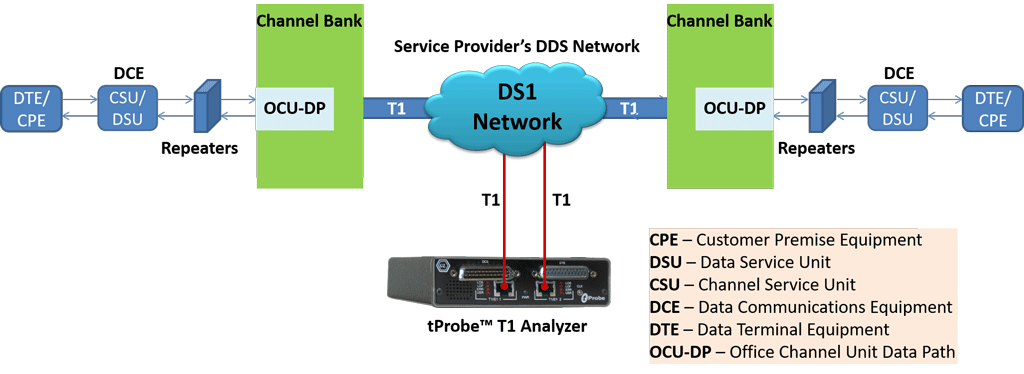Conventional Digital Signal Services (DDS) data channel may utilize multiple, all, or a fractional timeslot of the T1 line, with the transmission rates of 2.4 kbps, 4.8 kbps, 9.6 kbps, 19.2 kbps, and 56 kbps. As depicted in the main diagram, the DDS circuit starts with customer premises equipment that can include a computer or a Data Terminal Equipment (DTE), a Data Service Unit (DSU)/Channel Service Unit (CSU).
The Unformatted customer data are transmitted from the DTE, and then passed through a DSU/CSU before being transmitted over the local loop. Depending on the length of the loop, repeaters may be needed along the loop to regenerate the signal.
The local loop signal is formatted into a DS0 signal by the Office Channel Unit-Data-Port card (OCU-DP) and multiplexes the customer signal into one of the 24 timeslots of a T1 signal. DDS networks accept data from the customer at various standard rates. Full-duplex, synchronous data transmission has been available at 56kbps and standard sub-rates of 2.4 kbps, 4.8 kbps, 9.6 kbps etc. To multiplex a sub rate signal into a 64 kbps time slot, DDS uses a technique known as Byte Stuffing, by which, customer information is repeated the required number of times to create a 64 kbps DS0 signal.
Normal testing methods used to verify DDS circuits are –
- BERT Testing at DS0 level with standard set of pseudorandom and fixed patterns
- Subrate testing at 2.4, 4.8, 9.6,19.2, and up to 64 kbps
- Loopback or end-to-end tests to isolate faulty DDS circuits
- Non-Intrusive monitoring and analysis of frames at certain points within the network infrastructure or at customer premises
GL supports non-intrusive monitoring and analysis of DDS frames using T1 Analyzer hardware. The captured data can be decoded and analysed by GL’s DDS Protocol Analyzer (Item No: XX102). Currently the analyzer supports 9.6 kbps data rates only.
GL Communications supports real-time and offline DDS Protocol Analyzer (Pre-requisites: GL’s field proven T1 internal PCI based analyzer cards or USB Laptop T1 based analyzer external units, required licenses and Windows® 7 or above Operating System). This helps in real-time and proactive monitoring and analysis.
Non-intrusive TAPs are used to passively duplicate the signal between two end points on a network link without disturbing the actual network activity. Any of GL’s T1 Analyzer hardware can be used with RJ48 Y Bridge (splits one RJ48 into two complete) to non-intrusively tap and capture the DDS frames on a T1 line.
The DDS data is formatted into frames separated by one or more bytes. The data channel may utilize multiple, all or a fractional timeslot of the T1 line. Also, there may be multiple data channels within the T1 line. The captured data analyzed using GL’s DDS Protocol Analyzer application.
Main Features
|
Display Features |
|
|
Capturing Streams |
|
|
Export Options |
|
|
Additional Features |
|





